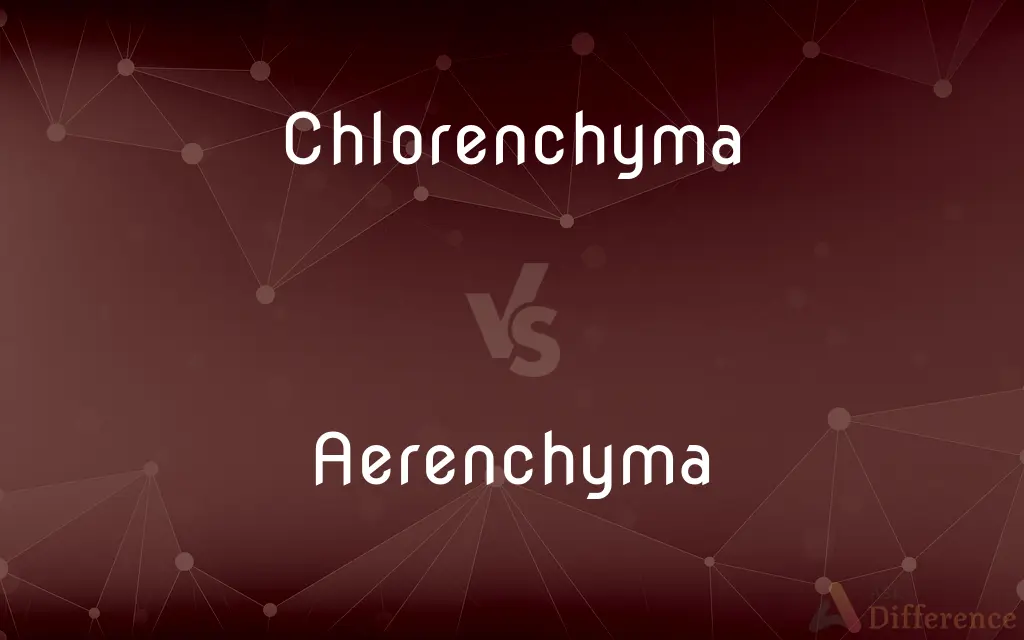Chlorenchyma vs. Aerenchyma — What's the Difference?
Edited by Tayyaba Rehman — By Fiza Rafique — Updated on March 20, 2024
Chlorenchyma contains chloroplasts for photosynthesis, while aerenchyma features large air spaces for gas exchange and buoyancy in aquatic plants.

Difference Between Chlorenchyma and Aerenchyma
Table of Contents
ADVERTISEMENT
Key Differences
Chlorenchyma is specialized plant tissue primarily involved in photosynthesis, characterized by its green color due to the presence of chloroplasts. These chloroplasts enable the plant to convert sunlight into energy through the process of photosynthesis, making chlorenchyma crucial for the plant's growth and survival. In contrast, aerenchyma is a tissue adapted for gas exchange and buoyancy, particularly in aquatic plants. It contains large air spaces that facilitate the movement of gases such as oxygen and carbon dioxide, and also helps aquatic plants remain buoyant.
While chlorenchyma is found throughout various parts of a plant, including leaves, stems, and young green fruits, reflecting its role in photosynthesis, aerenchyma is typically found in the roots and stems of plants that grow in water or waterlogged soils. This distribution underscores the different environmental adaptations of each tissue type; chlorenchyma maximizes exposure to light for photosynthesis, whereas aerenchyma ensures that plants can survive and perform gas exchange in anaerobic or low-oxygen conditions.
The structure of chlorenchyma is such that it maximizes light absorption, with closely packed cells containing numerous chloroplasts. This dense arrangement is conducive to efficient photosynthesis. On the other hand, aerenchyma's structure is defined by large intercellular air spaces, which reduce the tissue's density and allow for easy gas diffusion, as well as providing buoyancy to plants in aquatic environments.
In terms of function, chlorenchyma is directly involved in the production of food for the plant through photosynthesis, which is essential for the growth and energy needs of nearly all parts of the plant. Aerenchyma, while not directly involved in food production, plays a critical support role by ensuring that underwater parts of the plant receive sufficient oxygen and that the plant can float, thus accessing light for its chlorenchyma to perform photosynthesis.
Both chlorenchyma and aerenchyma are examples of how plants have evolved specialized tissues to adapt to their environments and meet their physiological needs. Chlorenchyma adapts plants to maximize energy production, while aerenchyma enables plants to survive and thrive in aquatic or flooded conditions, demonstrating the diversity and adaptability of plant tissue functions.
ADVERTISEMENT
Comparison Chart
Primary Function
Photosynthesis
Gas exchange and buoyancy
Location
Leaves, stems, green fruits
Roots and stems, especially in aquatic plants
Characteristic Cells
Chloroplast-rich for light absorption
Large air spaces for gas diffusion and buoyancy
Environmental Adaptation
Maximizes light exposure for energy production
Supports survival in anaerobic or aquatic conditions
Structural Feature
Densely packed cells with chloroplasts
Loosely arranged cells with large intercellular spaces
Compare with Definitions
Chlorenchyma
Contains chloroplasts.
Each cell within the chlorenchyma is packed with chloroplasts to absorb sunlight efficiently.
Aerenchyma
Facilitates gas exchange.
Aerenchyma in aquatic plants ensures that oxygen reaches all parts of the plant.
Chlorenchyma
Found in green plant parts.
The green stem of a young plant is rich in chlorenchyma, contributing to its growth.
Aerenchyma
Features large air spaces.
The large air spaces in aerenchyma tissue help plants float in water.
Chlorenchyma
Specialized for photosynthesis.
The chlorenchyma in the leaves is where most of the plant's photosynthesis occurs.
Aerenchyma
Adapted to aquatic environments.
In waterlogged soils, aerenchyma enables plants to survive by providing oxygen.
Chlorenchyma
Adapted for maximum light absorption.
The arrangement of chlorenchyma cells optimizes the plant's ability to capture sunlight.
Aerenchyma
Provides buoyancy.
The air-filled spaces in aerenchyma not only aid in gas exchange but also keep aquatic plants afloat.
Chlorenchyma
Crucial for plant energy.
Without chlorenchyma, plants wouldn't be able to produce the energy they need to survive.
Aerenchyma
Helps in stress conditions.
Even in non-aquatic plants, aerenchyma can form in response to environmental stress like flooding.
Chlorenchyma
Plant tissue consisting of parenchyma cells that contain chloroplasts.
Aerenchyma
Aerenchyma or aeriferous parenchyma is a modification of the parenchyma to form a spongy tissue that creates spaces or air channels in the leaves, stems and roots of some plants, which allows exchange of gases between the shoot and the root. The channels of air-filled cavities (see image to right) provide a low-resistance internal pathway for the exchange of gases such as oxygen and ethylene between the plant above the water and the submerged tissues.
Chlorenchyma
(botany) A mechanical, supportive ground tissue in plants containing chloroplasts.
Aerenchyma
A spongy tissue with large intercellular air spaces that is found in aquatic plants. It provides buoyancy and allows the circulation of gases.
Chlorenchyma
Parenchyma whose cells contain chloroplasts
Aerenchyma
(botany) A spongy, airy tissue found especially in the roots of aquatic plants
Common Curiosities
Can aerenchyma be found in non-aquatic plants?
Yes, aerenchyma can also develop in non-aquatic plants under conditions of environmental stress, such as soil flooding.
Is chlorenchyma present in all green parts of a plant?
Yes, chlorenchyma is typically found in all green parts of a plant, including leaves, stems, and young fruits, wherever photosynthesis occurs.
What is the main role of chlorenchyma in plants?
Chlorenchyma's main role is to facilitate photosynthesis through its chloroplast-rich cells, converting sunlight into energy for the plant.
Does aerenchyma formation require specific environmental conditions?
While common in aquatic plants, aerenchyma can also form in terrestrial plants under stress conditions like flooding that induce hypoxia.
What happens to aerenchyma tissue when a plant is removed from water?
If an aquatic plant with aerenchyma is removed from water, it may lose its buoyancy and structural support, potentially leading to wilting or collapse.
How does the structure of chlorenchyma enhance photosynthesis?
The structure of chlorenchyma, with densely packed chloroplast-rich cells, maximizes light absorption and efficiency of photosynthesis.
How does aerenchyma contribute to a plant's survival in aquatic environments?
Aerenchyma contributes by providing large air spaces for efficient gas exchange and buoyancy, enabling aquatic plants to access light and breathe underwater.
What is the significance of chlorenchyma in plant growth?
Chlorenchyma is crucial for plant growth as it is the site of photosynthesis, which produces the sugars needed for growth and development.
Can chlorenchyma and aerenchyma coexist in the same plant?
Yes, plants, especially those in wet or aquatic environments, can have both chlorenchyma for photosynthesis and aerenchyma for buoyancy and gas exchange.
How do the air spaces in aerenchyma form?
Air spaces in aerenchyma can form through cell death and lysis or through the separation of cells, creating large gas-filled cavities.
Share Your Discovery

Previous Comparison
Pride vs. Vanity
Next Comparison
Control vs. DominateAuthor Spotlight
Written by
Fiza RafiqueFiza Rafique is a skilled content writer at AskDifference.com, where she meticulously refines and enhances written pieces. Drawing from her vast editorial expertise, Fiza ensures clarity, accuracy, and precision in every article. Passionate about language, she continually seeks to elevate the quality of content for readers worldwide.
Edited by
Tayyaba RehmanTayyaba Rehman is a distinguished writer, currently serving as a primary contributor to askdifference.com. As a researcher in semantics and etymology, Tayyaba's passion for the complexity of languages and their distinctions has found a perfect home on the platform. Tayyaba delves into the intricacies of language, distinguishing between commonly confused words and phrases, thereby providing clarity for readers worldwide.














































